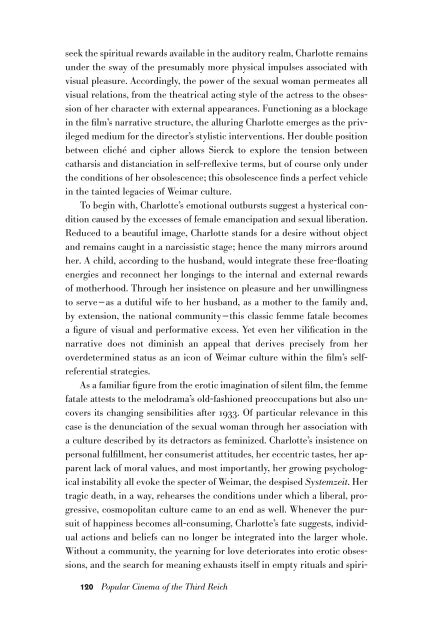Create successful ePaper yourself
Turn your PDF publications into a flip-book with our unique Google optimized e-Paper software.
seek the spiritual rewards available in the auditory realm, Charlotte remains<br />
under the sway of the presumably more physical impulses associated with<br />
visual pleasure. Accordingly, the power of the sexual woman permeates all<br />
visual relations, from the theatrical acting style of the actress to the obsession<br />
of her character with external appearances. Functioning as a blockage<br />
in the film’s narrative structure, the alluring Charlotte emerges as the privileged<br />
medium for the director’s stylistic interventions. Her double position<br />
between cliché and cipher allows Sierck to explore the tension between<br />
catharsis and distanciation in self-reflexive terms, but of course only under<br />
the conditions of her obsolescence; this obsolescence finds a perfect vehicle<br />
in the tainted legacies of Weimar culture.<br />
To begin with, Charlotte’s emotional outbursts suggest a hysterical condition<br />
caused by the excesses of female emancipation and sexual liberation.<br />
Reduced to a beautiful image, Charlotte stands for a desire without object<br />
and remains caught in a narcissistic stage; hence the many mirrors around<br />
her. A child, according to the husband, would integrate these free-floating<br />
energies and reconnect her longings to the internal and external rewards<br />
of motherhood. Through her insistence on pleasure and her unwillingness<br />
to serve—as a dutiful wife to her husband, as a mother to the family and,<br />
by extension, the national community—this classic femme fatale becomes<br />
a figure of visual and performative excess. Yet even her vilification in the<br />
narrative does not diminish an appeal that derives precisely from her<br />
overdetermined status as an icon of Weimar culture within the film’s selfreferential<br />
strategies.<br />
As a familiar figure from the erotic imagination of silent film, the femme<br />
fatale attests to the melodrama’s old-fashioned preoccupations but also uncovers<br />
its changing sensibilities after 1933. Of particular relevance in this<br />
case is the denunciation of the sexual woman through her association with<br />
a culture described by its detractors as feminized. Charlotte’s insistence on<br />
personal fulfillment, her consumerist attitudes, her eccentric tastes, her apparent<br />
lack of moral values, and most importantly, her growing psychological<br />
instability all evoke the specter of Weimar, the despised Systemzeit. Her<br />
tragic death, in a way, rehearses the conditions under which a liberal, progressive,<br />
cosmopolitan culture came to an end as well. Whenever the pursuit<br />
of happiness becomes all-consuming, Charlotte’s fate suggests, individual<br />
actions and beliefs can no longer be integrated into the larger whole.<br />
Without a community, the yearning for love deteriorates into erotic obsessions,<br />
and the search for meaning exhausts itself in empty rituals and spiri-<br />
120 Popular Cinema of the Third Reich

















